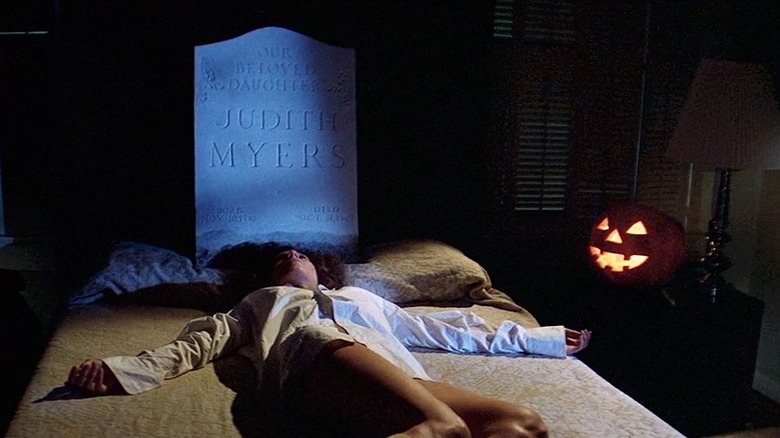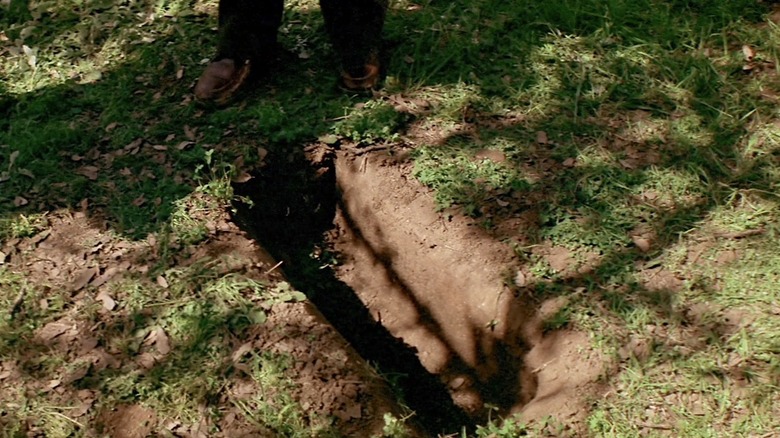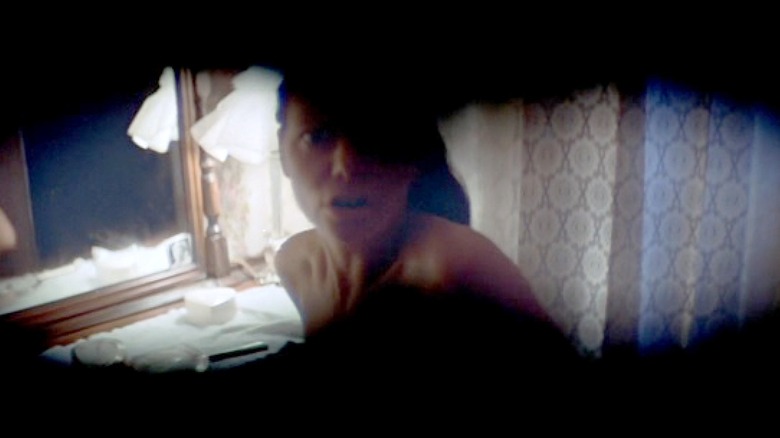Recreating Halloween's Judith Myers Tombstone Was Particularly Challenging
John Carpenter's 1978 film "Halloween" begins with a prologue in 1963 wherein a six-year-old Michael Myers (Will Sandin), with no discernible motivation, takes a knife from his family kitchen, brings it upstairs, and slays his big sister Judith (Sandy Johnson). Michael was immediately taken to a mental asylum where he didn't speak a word for 15 years. His psychiatrist Dr. Loomis (Donald Pleasance) tried to reach through to Michael, aiming to discern why he might have killed his sister, but ultimately found that Michael was merely, irretrievably evil. Naturally, in 1978, Michael escaped the asylum and returned to his childhood home in Haddonfield, Illinois.
There is a notable scene wherein Dr. Loomis visits the grave of Judith Myers in 1978, only to find that the tombstone had been dug up out of the ground and stolen. The tombstone will reappear late in the film when Michael, now wearing a mask and committing multiple murders, arranges it on the bed of a victim, posing her as if she were also his deceased sister. One can only imagine the physical struggle Michael went through, lugging a massive stone slab up the stairs of a suburban home in the middle of the night. A 24" by 12" by 3" granite tombstone, a small one, weighs about 86 pounds.
That tombstone was recreated for David Gordon Green's 2018 "Halloween" sequel, also called "Halloween," and it seems that the filmmakers were not content to make the new tombstone look fake. According to Abbie Bernstein's new book "Halloween: The Official Making of Halloween, Halloween Kills and Halloween Ends," the prop Judith Myers tombstone made for the 2019 movie was not a styrofoam mockup, but a real stone slab.
Recreating the 1978 prop tombstone in actual granite proved to be massively difficult.
They got it wrong
It seems the makers of the 2018 "Halloween" contacted a tombstone-making company with very exacting specifications. The font had to be just right, as did the placement of Jusith Myers' name on the stone. It had to look just like the 1978 tombstone. It's likely (though not confirmed) that the propmaster included a picture to go by. Sadly, the tombstone company, operating by their own caprices, returned the order incorrectly. Production designer Richard A. Wright recalled the debacle:
"[Most prop tombstones] are made of foam, but our 'hero' one, Michael's sister's, is a real tombstone. We had a tombstone company make it for us, [copied as] closely as we could from the original film. The tombstone arrived a few days before we were going to shoot, and they had changed the font, and made it a little low. I think 80% of viewers wouldn't have noticed the difference, but because wed all been studying the film for so long, we knew it was wrong. So after having two months to make this perfect tombstone, we had to scramble."
The tombstone company is not named. While I'm sure it would have been a fine tombstone if used for its intended purpose, it would have served well, but Wright needed something very specific. The company wouldn't be able to cut a new stone in time for the rest of the film's shoot, so Wright had to get creative. He merely took the tombstone he had — a massive granite slab — and repurposed it.
Aging a tombstone
The timeline of the 2018 "Halloween" follows the same timeline as the 1978 original, so it was technically the same tombstone; Green's "Halloween" only ignored the many "Halloween" sequels, not the 1978 original. As such, it was still the same Judith Myers lying buried, and it was still erected in 1963. And what would a 55-year-old tombstone look like? It seems that Wright and his crew not only had to re-engrave the stone but age it as well. Perhaps the shaving and re-engraving process aided in making the brand-new tombstone look like it was already 55. Wright recalls the entire process, all enacted in a panic. The shooting was to begin shortly, and one of its key props was required.
One can admire Wright's tenacity and resourcefulness. He recalled:
"We couldn't find any more granite quickly enough for the shoot, so we had to take that tombstone and grind it down flat again, and then re-engrave it, and it was ready probably hours before it needed to be installed. It was a very stressful weekend. But I think it looks great. And then once installed, we took some time to try and age it, to make it feel like it had been vandalized and patched and then cleaned and then vandalized again and cleaned again."
The finished tombstone looked perfectly fine. Like many major films, a lot of the actual filming required last-minute changes and panicked re-workings due to unexpected events. People like Wright keep most film productions afloat. Kudos to him and his team.


